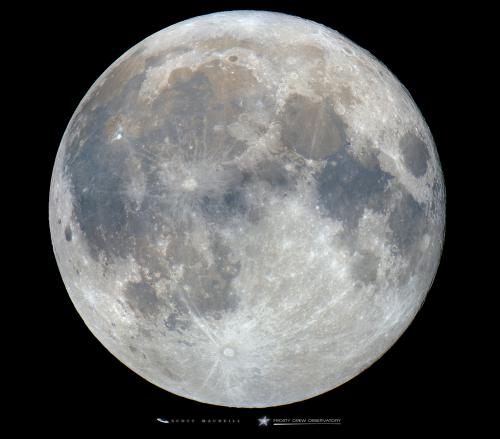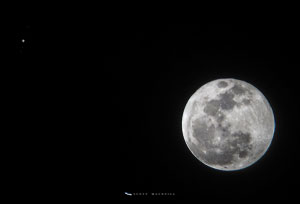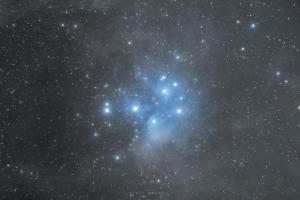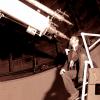Celebration of Space - September 2, 2022

The Harvest Moon captured with the 16 inch Meade telescope at Frosty Drew Observatory. Credit: Frosty Drew Astronomy Team Member, Scott MacNeill.
A Change is Happening to our Stargazing Nights Events:
Starting next Friday, September 9, 2022, and continuing into the New Year, our weekly Stargazing Nights events will require ticketed registration for visitors to gain access to our campus. Tickets are free, but a $5 per person donation is greatly appreciated. Tickets will become available on the Monday morning preceding the event, regardless of weather forecasts for the event date. Tickets are free, and donations made online are non-refundable. Our events are weather dependent, especially telescope observations, which require relatively clear sky conditions. If an event is canceled, the event page for that night, as well as our newsletter, and social media will list the event as canceled. We also may offer a cloudy night program that will offer presentations, tours, and exhibits, but not telescope observation. Ticket holders will not be notified of event changes, and will have to check our online resources before setting out that night. Additionally, we will no longer publish information about events on Friday afternoon to our Facebook, but instead will create events using the event tools on Facebook. We are making this change to help streamline event registration, as well as to address the Friday afternoon rush to get tickets, which causes events to sell out very quickly. We will evaluate the need to continually require tickets and registration during the winter months, after the New Year. Thank you for your patience with this change, as we think it will ultimately be easier for our visitors to attend our events.
On Saturday, September 10, 2022 at 5:59 am ET, the September Full Moon, which is the last full Moon of summer, will occur. Contrary to popular belief the September Full Moon carries the name: The Full Corn Moon. Though most sky watchers will refer to the September Moon as the Harvest Moon, which in 2022 is correct. The Harvest Moon usually occurs in September, but not always. This is because the Harvest Moon is defined as the closest full Moon to the Autumnal Equinox. The 2022 Autumnal Equinox will occur on September 22nd at 9:04 pm ET. The Full October Moon will occur on October 9th at 5:55 pm ET, which places the September Moon as the closest full Moon to the Equinox. The Harvest Moon is a fabulous harbinger of Autumn in the Northern Hemisphere, but is it really bright enough to harvest crops under?
The answer is yes, but not only to the Harvest Moon, but to any full Moon of the year. The Harvest Moon is not any brighter or larger than any other regular full Moon. The reason it is the full Moon that crops are harvested under is due to the phase occurring during the harvest, not because the Moon is brighter or bigger. In any case, the media will explode with news, and pictures of the huge Harvest Moon, and we will hear from visitors and friends about how the Harvest Moon is the biggest and brightest full Moon they have ever seen. Though autumn is probably the most liked season of the year, and since the Harvest Moon calls in the season, it is well worth a little extra celebration and excitement. Being that the Harvest Moon is happening early Saturday morning, the best night to observe will be Friday, September 9th, which just happens to be our Stargazing Night. So stop in that night and welcome the coming autumn with a stunning view of the Harvest Moon in the big telescope.
Riding the tails of the summer season starts to bring the anticipation of autumn. In the sky we begin to see the autumn constellations rising during the evening hours, with the wintertime constellations becoming very visible in the morning hours. One of the most popular objects to observe in the autumn sky is the fantastic Andromeda Galaxy.
Andromeda is the largest galaxy in the Local Group of galaxies, which is the home group of the Milky Way galaxy. The Andromeda galaxy is naked eye visible from super dark locations, like Frosty Drew, but it will appear like a dim puff of cloud in the sky. In reality the diameter of Andromeda in the night sky spans the width of six full Moons. The galaxy resides at a distance of 2.5 million light years distant, making it the furthest object we can see with the naked eye at Frosty Drew. A look at Andromeda in the telescope will reveal the bright galactic nucleus, and the dim dust lanes of the spiral arms, which are comprised of cold hydrogen gas, bright star forming nebulae, and young star clusters. In the telescope you will also notice two smaller satellite galaxies around Andromeda, called Messier 32 and Messier 110. If you haven’t seen Andromeda in a telescope, but have binoculars, then you are set up already for a fantastic view. With Andromeda being so big in the sky, large telescopes can only show specific regions of the galaxy. To get a view of the entire galaxy, you need a wide field view, like that of binoculars, or low power backyard telescopes. Take a moment and check out this stunning image of the Andromeda Galaxy captured by Frosty Drew Astronomy Intern, Mara DeCesare during summer 2020 for her intern project. Then stop in at Frosty Drew over the next several months on a night with no Moon and check out the Andromeda Galaxy with your own eyes.
If you are out during the morning hours checking out the Andromeda Galaxy as it approaches the zenith (top of the sky), you will also notice a wintertime object rising in the eastern sky, The Pleiades. Often mistaken as the Little Dipper, The Pleiades is the brightest of all objects in the Messier Catalog of deep sky objects. It is listed as Messier 45, and it is actually an open star cluster that resides in the constellation Taurus.
An open star cluster is a grouping of young stars that all formed from the same nebula. Once the nebula that the stars formed from disperses, the young cluster of stars will emerge. Most open star clusters have about 2,000 solar masses (mass of the Sun) that make up the stellar population, which are bound together by their combined gravity. Though the gravitational balance is easily disturbed, and as the cluster begins interacting with other nebulae, supernova remnants, or other events along the interstellar medium, the cluster will begin to break up into independent star systems, like the Solar System.
The Pleiades is one of the closest open star clusters to the Solar System as well, residing at a distance of 445 light years. It is frequently referred to as The Seven Sisters, due to the ability to spot seven stars when observing with the naked eye. When observing from a dark location, like Frosty Drew, you will notice a faint blue hue in the background around the stars in the cluster. This is the result of a nebula that is currently passing through the star cluster. The bright blue stars of the cluster are casting their intense blue light into the nebula causing it to glow. This is referred to as a Reflection Nebula. For a while we thought that the nebula around the Pleiades may be the nebula that the cluster formed from, though recent evidence has proven otherwise. Even though the Pleiades starts to show up in the morning sky of late summer, it is actually a wintertime object, and the second harbinger of winter in the Northern Hemisphere, with the first harbinger being the bright star Capella in the constellation Auriga. We will write more about the Pleiades later this autumn, but in the meantime, step outside around 3:00 am, and take a look to the eastern sky to catch an early view of The Seven Sisters. Check out this image of The Pleiades that we captured at Frosty Drew Observatory in 2021.
- Author:
- Scott MacNeill
- Entry Date:
- Sep 2, 2022
- Published Under:
- Scott MacNeill's Columns




